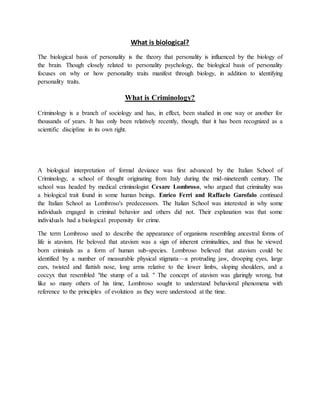
Biological school of thought
- 1. What is biological? The biological basis of personality is the theory that personality is influenced by the biology of the brain. Though closely related to personality psychology, the biological basis of personality focuses on why or how personality traits manifest through biology, in addition to identifying personality traits. What is Criminology? Criminology is a branch of sociology and has, in effect, been studied in one way or another for thousands of years. It has only been relatively recently, though, that it has been recognized as a scientific discipline in its own right. A biological interpretation of formal deviance was first advanced by the Italian School of Criminology, a school of thought originating from Italy during the mid-nineteenth century. The school was headed by medical criminologist Cesare Lombroso, who argued that criminality was a biological trait found in some human beings. Enrico Ferri and Raffaelo Garofalo continued the Italian School as Lombroso's predecessors. The Italian School was interested in why some individuals engaged in criminal behavior and others did not. Their explanation was that some individuals had a biological propensity for crime. The term Lombroso used to describe the appearance of organisms resembling ancestral forms of life is atavism. He beloved that atavism was a sign of inherent criminalities, and thus he viewed born criminals as a form of human sub-species. Lombroso believed that atavism could be identified by a number of measurable physical stigmata—a protruding jaw, drooping eyes, large ears, twisted and flattish nose, long arms relative to the lower limbs, sloping shoulders, and a coccyx that resembled "the stump of a tail. " The concept of atavism was glaringly wrong, but like so many others of his time, Lombroso sought to understand behavioral phenomena with reference to the principles of evolution as they were understood at the time.
- 2. Biological theories within the field of criminology attempt to explain behaviors contrary to societal expectations through examination of individual characteristics. These theories are categorized within a paradigm called positivism (also known as determinism), which asserts that behaviors, including law-violating behaviors, are determined by factors largely beyond individual control. Positivist theories contrast with classical theories, which argue that people generally choose their behaviors in rational processes of logical decision making, and with critical theories, which critique lawmaking, social stratification, and the unequal distribution of power and wealth. Positivist theories are further classified on the basis of the types of external influences they identify as potentially determinative of individual behavior. For example, psychological and psychiatric theories look at an individual’s mental development and functioning; sociological theories evaluate the impact of social structure on individuals (e.g., social disorganization, anomie, sub cultural theories, opportunity, strain) and the impact of social function and processes on individuals (e.g., differential association, social learning, social bonds, labeling). Biological theories can be classified into three types: (1) Those that attempt to differentiate among individuals on the basis of certain innate (i.e., those with which you are born) outward physical traits or characteristics; (2) Those that attempt to trace the source of differences to genetic or hereditary characteristics; and (3) Those that attempt to distinguish among individuals on the basis of structural, functional, or chemical differences in the brain or body.
